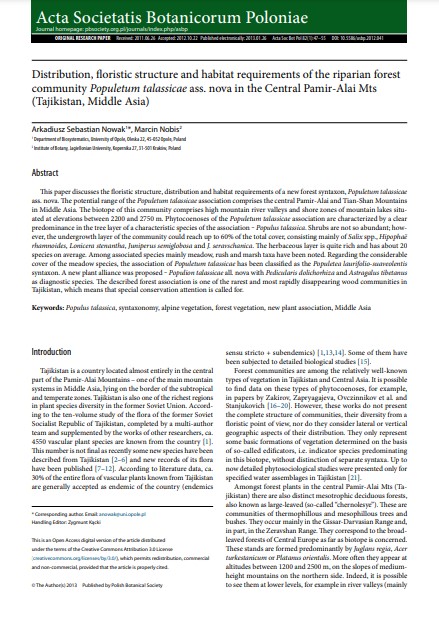Distribution, floristic structure and habitat requirements of the riparian forest community Populetum talassicae ass. nova in the Central Pamir-Alai Mts (Tajikistan, Middle Asia)
Bosque Modelo:
Nova Forest Alliance
Temática:
Conservación
Tipo de documento:
Artículo científico
Resumen
This paper discusses the floristic structure, distribution and habitat requirements of a new forest syntaxon, Populetum talassicae ass. nova. The potential range of the Populetum talassicae association comprises the central Pamir-Alai and Tian-Shan Mountains in Middle Asia. The biotope of this community comprises high mountain river valleys and shore zones of mountain lakes situated at elevations between 2200 and 2750 m. Phytocoenoses of the Populetum talassicae association are characterized by a clear predominance in the tree layer of a characteristic species of the association ‒ Populus talassica. Shrubs are not so abundant; however, the undergrowth layer of the community could reach up to 60% of the total cover, consisting mainly of Salix spp., Hipophaë rhamnoides, Lonicera stenantha, Juniperus semiglobosa and J. seravschanica. The herbaceous layer is quite rich and has about 20 species on average. Among associated species mainly meadow, rush and marsh taxa have been noted. Regarding the considerable cover of the meadow species, the association of Populetum talassicae has been classified as the Populetea laurifolio-suaveolentis syntaxon. A new plant alliance was proposed ‒ Populion talassicae all. nova with Pedicularis dolichorhiza and Astragalus tibetanus as diagnostic species. The described forest association is one of the rarest and most rapidly disappearing wood communities in Tajikistan, which means that special conservation attention is called for
Información Bibliográfica
Autor:
Nowak, Arkadiusz Sebastian; Nobis, Marcin
Revista:
ACTA SOCIETATIS BOTANICORUM POLONIAE
Año:
2013
N°:
1
País :
Canadá
Páginas:
47 - 55
Volumen:
82
Idioma:
Ingles
Palabras claves
Populus talassica, syntaxonomy, alpine vegetation, forest vegetation, new plant association, Middle Asia





